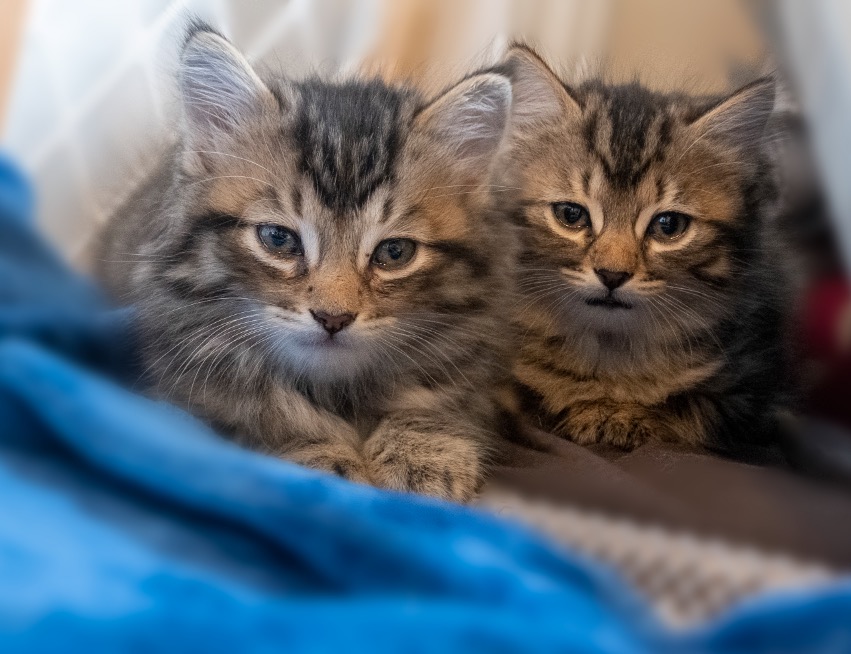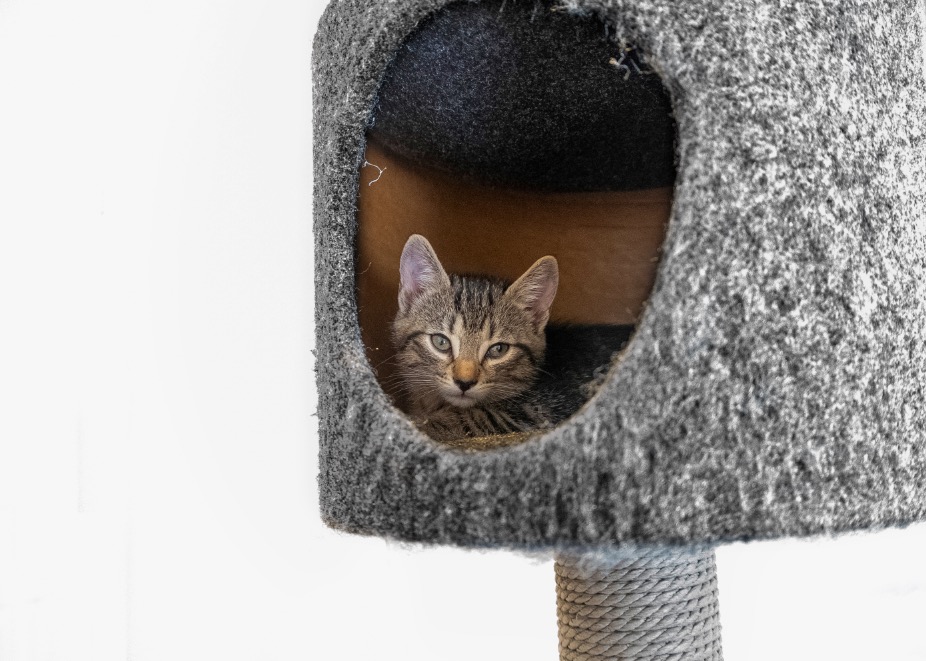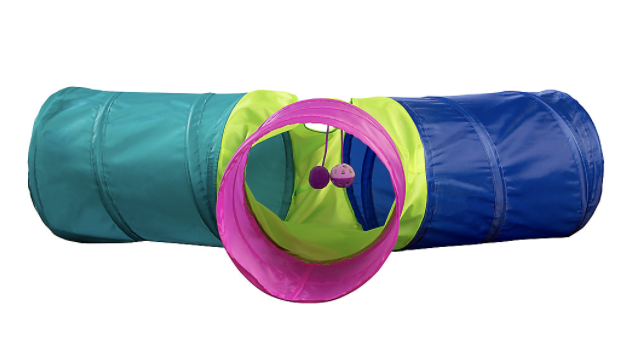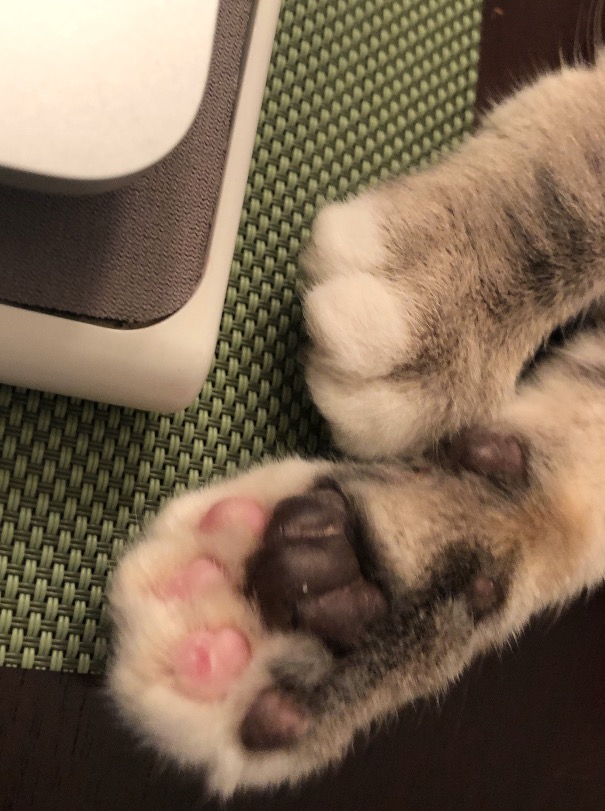Day 57
When we started this project, it had been a long, long time ago either of us had had kittens in the house. For me, the year 1999 was the last, so more than 20 years. For Wim it was even longer, in his childhood years. So when we committed to help Mitsy out with her new family, there were quite a few things we really had to sit down and think about it.
For instance, we had forgotten how natural it is for tiny newborns to burrow their heads into any opening that they can get into. This strong urge does not disappear as they get older. If anything, it gets more pronounced. I think this must come from the hunting instincts. Mice hide in small places like that, it is a natural inclination for cats to see if they can crawl in to find something interesting to play with or to eat… So, if you adopt a kitten into your household, one of the first things to do is to view the space you will keep them in through their eyes and make it as safe as possible.
No solo kittens

Before I get into some suggestions to make a success of your kitten-adoption: kittens that grew up in a full litter with siblings, should never be adopted into a household where there are no kittens at all. It will be very lonely and miserable, and it will miss its brothers and sisters terribly.
It will also tend to get into trouble, because it gets bored. Nobody to play with, nobody to sleep with to keep it warm and comfortable. Nobody to teach it how to be a social cat! If you happen to be at home all day and have the time and the energy to spend *a*l*o*t* of quality time with the kitten providing what it needs throughout the day, it might be OK. But these days the preference is to adopt in pairs or have a resident cat that is comfortable with the new critter and vice versa.
Confinement
The ultimate goal of having cats share your living space is to let them roam freely in the rooms they are allowed to use. But, as in our case, there is nothing wrong with creating a confined space where you can safely leave them if you are not present. It can be a dog kennel or crate, like the ones we used for the nursery. It can be a special room. As long as it can hold a sleeping bed/pet carrier, a place to lounge, a small litter box and bowls for food and water. A room with a view would be ideal, so that they can get some sun and daylight, just keep in mind that super-hot rooms do not agree with most cats. They get dehydrated easily. As they get comfortable with you and your house, you can allow them to explore other spaces, but the first space you give them, will often automatically stay their safe Basecamp.

Things to know before you pick up your new kitten….
Cats are creatures of habit. Your new kitten is house-broken and knows to drink water and eat food, wet and dry. The change to a new home is pretty big for kittens, so it is good to start out with a similar set-up as the one it is used to. Ask the foster home or adoption group for these things and get them in place before picking up the kitten:
1. What litter is the kitten used to? Open pan or covered litter-box?
2. What brand of wet food? What kind of kibble?
3. How many times per day was the kitten fed?
4. What toys was it fond of?
5. Is the kitten used to a house, or was it confined to a crate?
6. Is it a climber or a ground-dweller? (climbers appreciate a climbing tree!)
And of course, know the obvious: is the kitten timid rather than extrovert? Does it have any specific fears or likes? All of this is more important than how the kitten looks. The most important thing is to pick a kitten that fits your own character and temperament.
The answers to questions like these will help you help the kitten acclimate to your household more quickly. As it gets used to you and your living space, you can make a gradual change in food and litter.
Danger zones
Danger zones for kittens are any small spaces they can wiggle into but possibly cannot escape from. Make sure the covers of your vents are not loose. Remove loose cables, especially if they do not blend in. Anything that looks like it might be a tail or a thread will be irresistible to your kitten. There are cable-bite covers you could buy and apply, but why not take this opportunity and reorganise those loose ends?
Block the space under cabinets, behind fridges and other appliances with old t-shirts or pieces of carton as long as the kitten is not yet familiar with your house. As the kitten gets older and bigger and gets accustomed to its new home, these measurements are probably no longer needed, but put them in place until you are confident there will be no trouble.
Indoor versus outdoor
The biggest danger zone for cats is… the great outdoors. For the longest time I used to be in favour of letting my cats go outside. I felt it was torture to not let them out. But I have changed my opinion. Local wildlife here in Canada is an enormous danger, as is traffic and other circumstances, especially in suburbia and inner city areas. A cat that was born inside, like our kittens, never went outside, will not miss the outside, provided that the home offers enough distractions, challenges and safe places. Our resident cat Suzi never goes outside. She did escape once, in the very beginning though, despite us being attentive. Our yard is fenced, thank God for that, and I noticed a red cat circling the perimeter of our backyard through the windows and thought: “Hey, look, another ginger!” Then recognised her. She was in a total panic, and I was lucky enough to be able to get her back inside. She did not know what to do outside! She was petrified! She is completely OK with being an inside cat. She loves catching some rays of sun in the morning, sitting at the screendoor. But many cats will try to climb the screen, or paw it and before you know it, they are out and lost. So keep the windows closed in the space where your kittens are unsupervised!
Toys! Lots of toys!
Kittens have an astonishing level of energy. They can race around a room for what seems an eternity. If there are no toys, they will create them. They will find a chair to climb, carpet to chew on, small spaces to explore… the more toys you have and use them to play together, the better it is and the less chance of the kitten getting into trouble. If you cannot afford a lot of toys, have an empty carton box, offer up a roll of kitchen towel and save the rolls from toilet paper as toys. It is good for their psyche to play and distract them from total boredom and mischief. It also builds muscle and coordination.

Find a cat tree
Having an awesome cat tree is a toy, execercise and occupational therapy all rolled int one. It teaches the kittens about balance, how to use their nails, how to gauge their environment and that kind of stuff. The tree is theirs and they can mess around with it as much as they want. It is the cat-zone. Most cats are either ground dwellers or climbers, but all cats like to be active in a cat tree. If you cannot afford a manufactured cat tree, build something yourself using storage boxes, shelves and Ottomans. Cats do not have luxury wish lists. There are cheap carton scratch pads you can sprinkle with a bit of cat nip that will quickly become favourites.

Tunnels: our kittens’ top one toy
Our resident cats never took to tunnels as a toy. But the kittens use the one we bought for them so intensely, that I cannot imagine where else their play energy would go. We have the model named ‘Whisker City® Pop-Up Tri-Tunnel Cat Toy’ (for sale in most pet stores) and it looks like this:

It requires a bit of space and if you don’t attach it to something like a chair or the leg of a table, it will travel the whole room. I simply made a knot from the balls hanging on elastic bands inside the tunnel to tie it to a chair. Of course this toy works best when there at least 2 kittens but once they discover how much fun it is, they will spend a lot of time running through it and chasing each other.
Play! Lots of play!
Play is one of the keys to the heart of your kitten, I strongly believe that. The most important people in a domestic cat’s life are the person who brings food and the person who plays with them. If your cats develops into a lap cat, then the person whose lap they sleep in is number 3 on that list. Play is not just throwing a ball and letting them hunt it. Get involved and play with them until they pant or lie down and fall asleep! The preference it to do it before mealtime to prevent stomach pains. Whenever you play with them, do it in the same spaces, so that they do not even think about using your furniture to sharpen their nails.
Injuries
From my own experiences I can tell you that most injuries caused by domestic cats are caused by their human, not by cat aggression. As much fun as it is, for instance, to use your hands and feet as objects of play when they are little, it is not so funny when they are adults. Use your hands only to caress and feed the cat. Never use them to correct bad behaviour. And never use them as toys. Don’t fault a kitten that initially mistakes your leg for a climbing tree: they don’t do it on purpose. Take them off your leg and correct (see next section)
Corrections
Animals do not plan to get naughty. Scratching your furniture might not be perceived as a deadly sin. Don’t get angry at them or bring them back to the adoption center. Instead, teach them where the ‘no-go’ zones are. And be consistent. If they are not allowed on a chair, make no exceptions. Most animals can be conditioned to do or not do something. But they do not understand exceptions. It is confusing. My favourite correction method a simple plant sprayer with water. When they are somewhere I don’t want them, I give them a short squirt on their body (not on their face) and say a loud ‘Psssst’ at the same time. In due time, the sprayer is no longer required, all you have to do is say ‘pssst’ and they will remember that they are doing something or are in a place where you do not want them. Of course, this only works when you are physically with them. Which is also why I am not against creating a confined space for them to be when you are not around (see above).
Computer games
Did you know that cats quite like computer games? I have had multiple cats that could go nuts following the mouse indicator on my computer screen. A while ago, I was house sitting a 15 year old cat. She was very sick, but the owner did not know that at the time. The cat had come to them declawed (oh horror of all horrors!), and I thought that she was a bit moody because of arthritis. Ultimately it turned out she had terminal cancer. But that is a different story. When I first met this cat, she charged at me a couple of times and I thought to myself: this house sitting job will not be as much fun as I had hoped! But after 3 days she relaxed and we became fast friends. I work in IT and usually have one or the other device with me. And I wanted to see if she would be interested in playing on the iPad. It would require I had some cat games on it that our resident cats really likes. Not so much to truly play the game, but as visual stimulation and attraction. It was fabulous. This house sitting cat learned how to touch the screen to move fish and mice and really enjoyed doing this. She started to be more playful, in a general way.
Watch this video and make sure your sound is on, so you can hear her purring with delight!
I found out that our young Sipke is also warming up to the game…
The 2 games that really work well are: Mouse for Cats and Cat Fishing (Friskies). I found them in the App Store.
Declawing: torture
Declawing, which unfortunately is still allowed in Ontario (Oh no!), can be compared to removing the top part of your extremities’ joints; fingers and toes. It is not, as some think, like clipping nails. When this is done to cats, who naturally walk on their toes and fingers, they start to walk with ‘sagging feet’ and this causes an unnatural load on their joints, resulting in permanent bone and tendon pain.
On top of that, the pads under their feet often develop wounds and sore, as you can see in this picture.
And finally: it also means they have one less defensive tool, and often declawed cats start biting instead of scratching. In short: it is a horrendous surgery that should be banned everywhere.

Socialising kittens
Most of the cats in my life ‘talked’ to me. Meowing is not how cats communicate with each other in nature. It is used as a signal. It can mean: “I am in pain!”. Or it can be a warning, a threat or a sign of other discomfort (including hunger). When we as humans talk a lot to our cats, they will pick up on that and often start to respond in kind. By the same token: if you never communicate with your cat out loud, there is no reason for them to do so. You may get the ocassional “Prrt”, but meowing is probably not going to be part of their communication. If you like to have a really social cat, start right away with your verbal communication. Say their name often, if you want them to respond to it, even when they are not hungry. My spirit name is ‘Lady Talksalot’ and this was always underlined in my cats, that meowed in response to talk. I kind of liked it! And it seems to be working for our new kittens as well. We have heard two of them starting to produce the cutest small meows when they say hello to us (especially when we come in with food).
Cat language
I have read many books about cats and when you observe them in your home, you quickly start to pick up on these signs:
Cat ‘says’:
- Hello, happy to see you!
- Comes to you, back held high, tail straight up in the air
- I am thinking about something
- Licking itself in response to something, looking the other way
- I love/like you, I am in a mellow mood
- Does a slow blink with the eyes while looking at you
- I am liking this!
- Moves its back into your hand when you are petting it, gives you a head butt, licks you, purrs
- I am in a playful mood
- Tail up, in a question mark curl
- I am annoyed, stay away from me
- Sweeping tail from one and to the other
- I am in fear, I don’t like the situation or sound or action
- Ears move to the side of the head, lick lips, hisses
- I am ready to attack
- Ears flat, moving to the back of the head, lowering head, hissing, meowing, growling
- I am mock attacking you in play OR: that just scared the living daylights out of me
- Moves side of body towards you, back arched, tail bushy
- Fear, not to be mistaken for anger
- I am swiping my paw at you and hiss, then immediately retreat
- Anger
- I move towards you and follow you, even if you retreat. Leave or I will hurt you